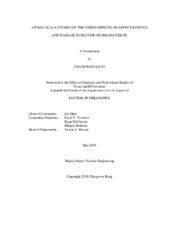| dc.description.abstract | Irradiation of the materials with neutrons or energetic particles creates a significant number of point defects and nucleates extended defects, such as dislocations and voids. These defects result in the changes of material properties and degradation. The knowledge of the evolution of damages under different irradiation conditions such as high temperature and stress is important to predict lifetime and guarantee the safety of the nuclear materials.
By means of molecular dynamics and statics simulations, the effects of strain on the damage production are examined. Interstitial is more affected by tensile strain along [111]. Otherwise, the motion of vacancy is more influenced by compressive strains. In displacement cascade of 10 keV primary knock-on atoms, increased defect production is obtained under strains. The increased diffusivity and anisotropic diffusion along specific directions affect recombination rates between interstitials and vacancies. We also investigate kinetic properties, formation and migration energies of defects in alpha Fe and identify their stable configurations under different strains. By applying uniaxial stress along [111], <111> oriented single SIA defects become more stable than <110> oriented SIA, which is opposite to stress-free condition. Diffusion of SIA defects under [111] tensile stress is facilitated along [111] direction and the diffusion becomes one dimensional (1D). The effects of compressive stress and strain on diffusivities of vacancy clusters are also investigated. The mechanisms of collapse of voids are also studied. We find that spherical voids in alpha-Fe under indentation along [111] direction
can emit and evolve into planar voids, following by super-fast 1D migration along [111] direction. The results are important to show that defect clusters with planar structure can be migrated to one dimensional with high diffusivity. Under a constant compressive strain, diffusivities of planar voids increase with increasing void sizes, except for a stable configuration of V9 which is able to convert back from a mobile planar void to immobile spherical voids.
The findings of present works are important to understand both mechanical property and defect evolution of irradiated metals, as expected in nuclear reactors. The information is also useful to develop the multiscale modeling of damages under strain environments. | en |


